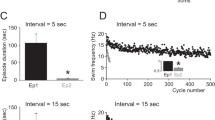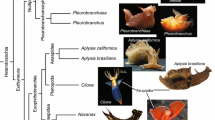Summary
-
1.
The swimming control systems of 13 hydromedusan species were examined electrophysiologically and morphologically. Despite obvious differences in the structure, behavior and life style of these medusae, the basic organization of swimming system components is similar.
-
2.
Motor neurons that activate swimming muscles are located in the inner nerve-ring comprising electrically-coupled condensed networks (Figs. 2, 3). Individual neurons of these networks are of far larger diameter than other neurons of the nerve-rings (Figs. 4–6).
-
3.
Spontaneous activity persists in the swim motor neuron networks in seawater containing excess Mg++ suggesting that the network may perform a pacemaker function.
-
4.
The swimming muscle sheet includes circular, striated epitheliomuscular cells of the subumbrella and velum, and an interposed non-muscular epithelial region which overlies the inner nerve-ring (Fig. 1). Gap junctions are common throughout this tissue sheet (Figs. 13, 14, 18). Electrical(Fig. 10) and dye-coupling (Fig. 3) of cells in this sheet suggests that direct current spread between myocytes is important in transmission of excitation throughout the subumbrella.
-
5.
Recordings from epithelial cells immediately adjacent to swim motor neurons reveal graded potentials presumably of synaptic origin (Figs. 2, 10). The synaptic potentials, and muscle action potentials, are blocked in seawater containing excess Mg++. Synaptic contacts were observed between swim motor neurons and overlying epithelial cells throughout the inner nerve-rings of all medusae examined (Figs. 19–21).
Similar content being viewed by others
References
Anderson PAV (1979) Ionic basis of action potential and bursting activity in the hydromedusan jellyfishPolyorchis penicillatus. J Exp Biol 78:299–302
Anderson PAV, Mackie GO (1977) Electrically coupled, photosensitive neurons control swimming in a jellyfish. Science 197:186–188
Chapman DM (1974) Cnidarian histology. In: Muscatine L, Eenhoff HM (eds) Coelenterate biology. Reviews and new perspectives. Academic Press, New York, pp 1–92
Filshie BK, Flower NE (1977) Junctional structures inHydra. J Cell Sci 23:151–172
Hand AR, Gobel S (1972) The structural organization of the septate and gap junctions ofHydra. J Cell Biol 50:397–408
Hertwig O, Hertwig R (1878) Das Nervensystem und die Sinnesorgane der Medusen. Vogel, Leipzig
Horridge GA (1955) The nerves and muscles of medusae. IV. Inhibition inAequorea forskalea. J Exp Biol 32:642–648
Hyman LH (1940) The invertebrates: Protozoa through Ctenophora. McGraw-Hill, New York, pp 400–497
Keough EM, Summers RG (1976) An ultrastructural investigation of the striated subumbrellar musculature of the anthomedusanPennaria tiarella. J Morphol 149:507–526
King MG, Spencer AN (1979) Gap and septate junctions in the excitable endoderm ofPolyorchis penicillatus (Hydrozoa, Anthomedusae). J Cell Sci 36:391–400
Kozloff EN (1974) Keys to the marine invertebrates of Puget sound, the San Juan Archipelago, and adjacent regions. University of Washington Press, Seattle (Washington)
Mackie GO (1971) Neurological complexity in medusae: A report of central nervous organization inSarsia. Actas del 1. Simposio International de Zoofilogenia, Salamanca, pp 269–280
Mackie GO (1973) Report of giant nerve fibers inNanomia. Publ Seto Mar Biol Lab 20:745–756
Mackie GO (1975) Neurobiology ofStomotoca. II. Pacemakers and conduction pathways. J Neurobiol 6:357–378
Mackie GO, Singla CL (1975) Neurobiology ofStomotoca. I. Action systems. J Neurobiol 6:339–356
Ohtsu K, Yoshida M (1973) Electrical activities of the anthomedusan,Spirocodon saltatrix (Tilesius). Biol Bull 145:532–547
Passano LM (1965) Pacemakers and activity patterns in medusae: homage to Romanes. Am Zool 5:465–481
Roberts A, Mackie GO (1980) The giant axon escape system of a hydrozoan medusa,Aglantha digitale. J Exp Biol 84:303–318
Romanes GJ (1876) Preliminary observations on the locomotor system of medusae. Philos Trans R Soc Lond [Biol] 166:269–313
Singla CL (1974) Ocelli of hydromedusae. Cell Tissue Res 149:413–429
Singla CL (1975) Statocysts of Hydromedusae. Cell Tissue Res 158:391–407
Singla CL (1978a) Fine structure of the neuromuscular system ofPolyorchis penicillatus (Hydromedusae, Cnidaria). Cell Tissue Res 193:163–174
Singla CL (1978b) Locomotion and neuromuscular system ofAglantha digitale. Cell Tissue Res 188:317–327
Spencer AN (1975) Behavior and electrical activity in the hydrozoanProboscidactyla flavicirrata (Brandt). II. The medusa. Biol Bull 149:236–250
Spencer AN (1978) Neurobiology ofPolyorchis. I. Function of effector systems. J Neurobiol 9:143–157
Spencer AN (1979) Neurobiology ofPolyorchis. II. Structure of effector systems. J Neurobiol 10:95–117
Spencer AN (1981) The parameters and properties of a group of electrically coupled neurons in the central nervous system of a hydrozoan jellyfish. J Exp Biol 93:33–50
Spencer AN, Satterlie RA (1980) Electrical and dye coupling in an identified group of neurons in a coelenterate. J Neurobiol 11:13–19
Spencer AN, Schwab WE (1982) The Hydrozoa. In: Shelton GAB (ed) Electrical conduction and behavior in “simple” invertebrates. Oxford University Press, Oxford
Stewart WW (1978) Functional connections between cells as revealed by dye-coupling with a highly fluorescent naphthalamide tracer. Cell 14:741–759
Author information
Authors and Affiliations
Additional information
A significant portion of this work was conducted at Friday Harbor Laboratories, Friday Harbor, Washington, USA and Bamfield Marine Station, Bamfield, British Columbia, Canada
Rights and permissions
About this article
Cite this article
Satterlie, R.A., Spencer, A.N. Neuronal control of locomotion in hydrozoan medusae. J. Comp. Physiol. 150, 195–206 (1983). https://doi.org/10.1007/BF00606369
Accepted:
Issue Date:
DOI: https://doi.org/10.1007/BF00606369




